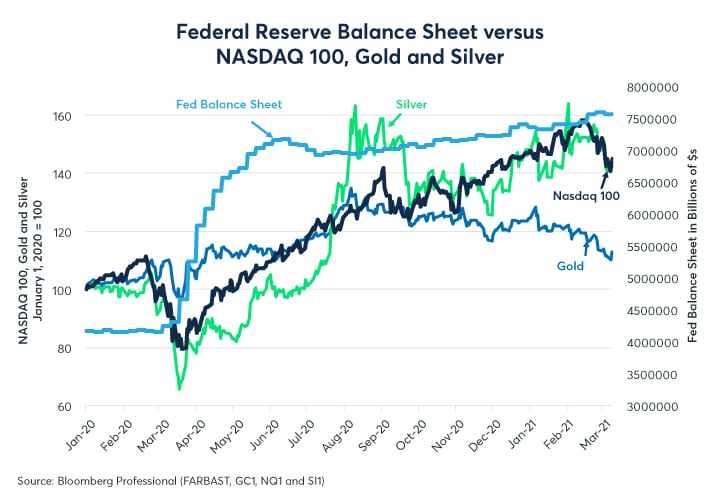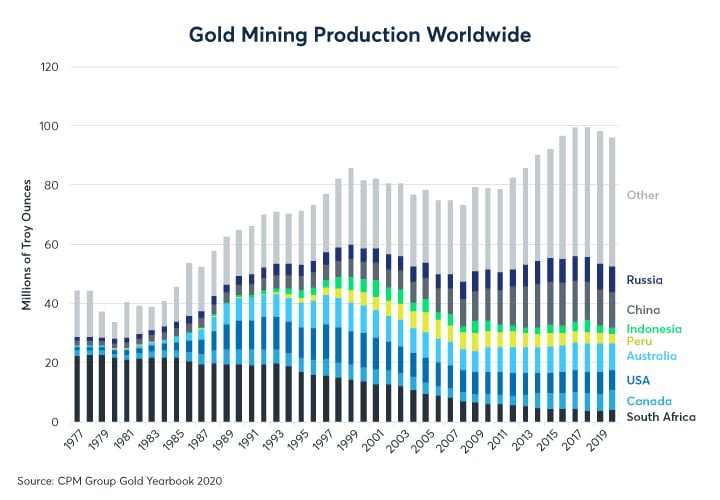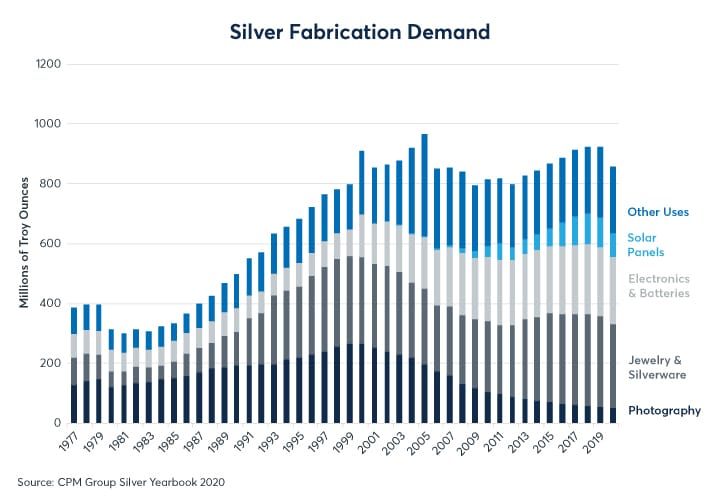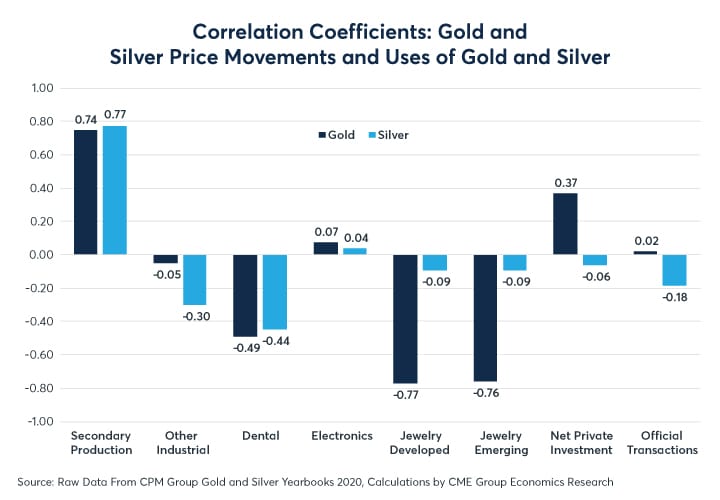Gold and silver analysis tends to typically focus on demand drivers, such as monetary and fiscal policy as well as their correlation with the U.S. dollar. For example, in the past 12 months, it has been widely assumed that balance sheet expansion by the Federal Reserve (Fed) and other central banks probably contributed to the rise in gold and silver prices (Figure 1).
Figure 1: QE probably contributed to the rise in prices of gold and silver
While demand factors are undeniably important, one should not overlook supply as a driver of precious metals prices. Gold and silver mining production has been on the decline since 2016. In 2020, the pandemic led to a number of mine closures that reduced output of gold and silver ore. Given the historical relationship between mining output and prices of precious metals, the recent decline in mining production, which has been especially sharp for silver, might have contributed to the rise in their prices.
Gold and silver mining supply has varied over time (Figures 2 and 3). Mining supply for both metals stagnated or fell during the 1970s, a period of soaring prices. Gold mining supply more than doubled between 1980 and 1998, a period when prices fell sharply for both metals. Silver mining supply rose during this period but not to the same extent. During this 18-year period, gold prices fell from $835 per ounce to as low as $280. Silver prices suffered an even larger percentage decline, falling from $50 per ounce to as low as $4.
Figure 2: Gold mining supply has been falling since 2016
Figure 3: Silver mining supply has been in a steep decline since 2016
Gold mining supply began falling in 1998 and didn’t hit bottom until 2009. Between 1999 and 2011 gold prices soared, rising 650%. In contrast, silver mining production rose from 1998 to 2009, increasing from 500 million troy ounces to nearly 700 million per year. Yet, despite rising mining output, silver prices rose even more than gold prices, increasing by 930% from 1999 to 2011.
Mining supply of gold rose in 2009, fell slightly in 2010 and 2011, and then climbed by over 20% between 2011 and 2016. Silver mining production soared during this period, and prices of both metals fell sharply, with silver falling by as much as 72% and gold by up to 45% from their 2011 highs.
Since 2016, gold and silver mining supply has fallen, with silver output dropping sharply. Gold prices began rising in early 2016. Silver prices didn’t hit bottom until early 2020, when they tumbled in the early stages of the pandemic, but subsequently soared by 150% between March and late July, when gold prices rose by a relatively meagre 40%.
Economists are unable to conduct controlled experiments and, thus, it is difficult to disentangle the influence of supply on precious metals prices from that of macroeconomic conditions. Did falling supply in the 1970s cause the rally in gold and silver prices? Given the high rate of consumer price inflation in the aftermath of the collapse of the Bretton Woods fixed exchange rate regime, it’s difficult to argue that mining supply was the main factor driving prices higher, especially given that prices for energy, industrial metals and agricultural products also soared during the 1970s.
Likewise, rising mining supply in the 1980s and 1990s coincided with tight monetary policy and high real interest rates. Falling gold output between 1998 and 2009 took place alongside the “tech wreck” recession and the global financial crisis which saw interest rates slashed to zero and the beginnings of quantitative easing (QE). The 2010s, however, come close to resembling a controlled experiment. From 2010 to 2016, mining output rose for both metals while monetary policy held steady, with rates stuck at zero in the U.S., Europe and Japan. The Fed did curtail QE but didn’t really begin to move rates higher until late 2016.
In 2017 and 2018, the Fed raised rates and began shrinking its balance sheet. Normally, this might have been bearish for gold prices, yet gold drifted higher during that period. This suggests that the positive price impact of reduced mining supply may have overwhelmed the negative impact of tighter U.S. monetary policy (eight rate hikes + balance sheet shrinkage). In 2019, the Fed began easing again and all other central banks subsequently eased monetary policy during the pandemic, to which gold and silver prices responded by heading higher.
How Silver and Gold Relate to One Another
Although gold and silver are both categorized as precious metals, and both metals usually correlate highly in their day-to-day price swings (Figure 4), there are vast differences in terms of both price and end use.
Figure 4: Gold and silver remain highly correlated despite an unstable gold-silver ratio
For starters, gold is much more expensive than silver. Since 1985, one ounce of gold was, on average, worth about 70 ounces of silver (Figure 5), with the gold-silver ratio ranging from 30 at the low end to over 120 at the high end. What this means is that although silver mining output measured in ounces is about 7-8x greater than gold mining output, when measured in dollars gold mining output is usually about 9-10x as valuable as silver mining output. This makes gold the dominant member of the gold-silver nexus. Moreover, it helps to explain why silver prices rose from 1999 to 2009 as gold mining output fell and even as silver mining output continued to rise, especially when looking at how the two metals are connected through their end use.
Figure 5: The gold-silver ratio has experienced wild swings in the past decade
Of the two metals, gold is used more in jewellery than silver. Of the 95 million ounces of gold mined in 2020, only about 14 million ounces were used in electronics or other industrial applications. About one million ounces were used in dentistry. The remaining 80 million ounces were made into jewellery or stored as gold bars in vaults (Figure 6). By contrast, only about 40% of silver is used to make jewellery. The rest is used in electronics, batteries, photography, solar panels and other industrial uses (Figure 7).
Figure 6: Gold is primarily used for jewellery and investment
Figure 7: Silver is also used a jewellery but has wider uses than gold
Economically, gold and silver are connected through the jewellery and investment markets. Because gold is more expensive and, in aggregate, the value of gold production dwarfs that of silver production, gold acts somewhat like a planet and silver like a moon. Together, they have a common center of gravity, but gold is the dominant member of the system.
When gold prices rise significantly, as they did between 1999 and 2011, that puts gold jewellery out of reach to many consumers. However, even if silver prices rise by, say, 9 or 10x, silver remains an affordable alternative for many customers at roughly 1/70th the price of gold. As such, perhaps its not surprising that jewellery demand for silver shows relatively little response to changes in silver prices in contrast to the extreme sensitivity of jewellery demand to changes in gold prices (Figure 8).
Figure 8: Silver jewellery consumption is much less price sensitive than gold jewellery
Besides the differing sensitivities of gold and silver jewellery demand to changes in their prices, another interesting feature is secondary supply. Secondary supply – recycled gold and silver – does not appear to be a driver of price. The market already knows that these supplies of gold and silver exist and they appear to have been taken into account when determining the price. Rather, rising precious metals prices incentivize more recycling of existing supplies. However, the recycling process does not appear to put downward pressure on prices.
A regression analysis allows us to see more clearly how changes in mining output from one year to the next influenced gold and silver prices. Measured over a 45-year period from the mid-1970s until now, it appears the changes in mining output of one metal influence the price of both metals. On average, a 1% increase in gold mining output sent gold prices 2.2% lower (t-statistic: -5.9) and silver prices 3.1% lower (t-statistic: -5.6). A 1% rise in silver mining output on average sent gold prices 1.8% lower, on average (t-statistic: -2.5), and silver prices 1.7% lower (t-statistic: -1.5) (Figure 9). All but the last of the t-statistics pass the 95% confidence interval test for significance.
Figure 9: Both metals show a negative sensitivity to their own and the others’ change in mining supply
Bottom Line
- Mining output is a significant driver of changes in gold and silver prices
- Gold mining output appears to have a major influence on both gold and silver prices
- Silver mining output appears to have a somewhat weaker influence on gold and silver prices
- When precious metals prices rise, jewellery buyers get priced out of gold but can often still afford silver
- Gold and silver are economically connected via the jewellery and investment markets
- Higher economic value makes gold the dominant member of the gold-silver system
- Secondary supply/production responds to price rather than drives it
To learn more about futures and options, go to Benzinga’s futures and options education resource.
© 2025 Benzinga.com. Benzinga does not provide investment advice. All rights reserved.
Trade confidently with insights and alerts from analyst ratings, free reports and breaking news that affects the stocks you care about.








